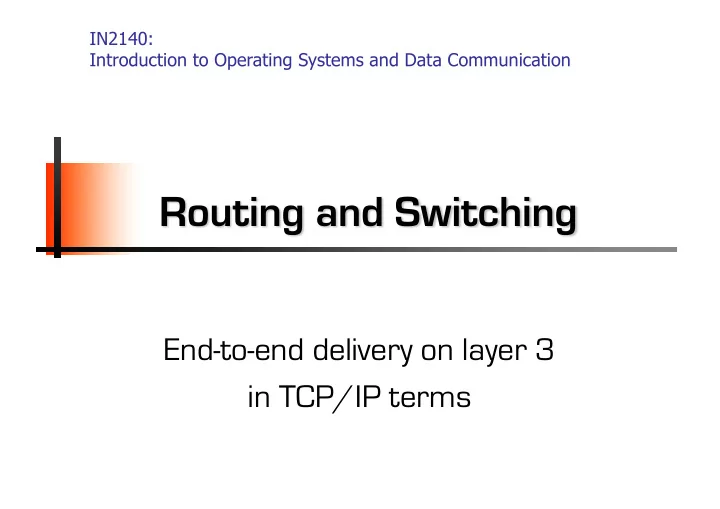

IN2140: Introduction to Operating Systems and Data Communication Routing and Switching End-to-end delivery on layer 3 in TCP/IP terms
Network Layer § Primary task from a layer model perspective − To provide service to the transport layer • Connectionless or connection-oriented service University of Oslo IN2140 – Introduction to operating systems and data communication
Network Layer § Primary task from a layer model perspective − To provide service to the transport layer • Connectionless or connection-oriented service • Uniform addressing • Internetworking: provide transitions between networks [unknown, 1920] University of Oslo IN2140 – Introduction to operating systems and data communication
Network Layer § Primary task from a layer model perspective − To provide service to the transport layer • Connectionless or connection-oriented service • Uniform addressing • Internetworking: provide transitions between networks • Routing University of Oslo IN2140 – Introduction to operating systems and data communication
Network Layer § Primary task from a layer model perspective − To provide service to the transport layer • Connectionless or connection-oriented service • Uniform addressing • Internetworking: provide transitions between networks • Routing • Congestion control [Giftzwerg 88@wikipedia, CC BY-SA 4.0] University of Oslo IN2140 – Introduction to operating systems and data communication
Network Layer § Primary task from a layer model perspective − To provide service to the transport layer • Connectionless or connection-oriented service • Uniform addressing • Internetworking: provide transitions between networks • Routing • Congestion control • Quality of Service (QoS) § Inside the network layer Layer Data entity Transport … Network Packet Data link Frame Physical Bit/byte (bit stream) University of Oslo IN2140 – Introduction to operating systems and data communication
Inside the Network Layer An L3 packet includes for connection-oriented service: • route label (2) headers and trailer to specify service requirements OR in particular: • information required by intermediate for connectionless service: systems for forwarding • end system address of the destination QoS requirements IPv6 Header Version DSCP ECN Flow label Payload length Next header Hop Limit (1) payload from the transport layer Source address (128 bit) Destination Address (128 bit) L4 Data University of Oslo IN2140 – Introduction to operating systems and data communication
Inside the Network Layer IPv6 Header § An L3 packet includes Version DSCP ECN Flow label Payload length Next header Hop Limit − Payload from the transport layer Source address (128 bit) − Headers and trailers • End system address or route label Destination Address (128 bit) • QoS requirements L4 Data § Knowledge required by intermediate system − Subnetwork topology − Address / localization of the end system − Packet / data stream communication requirements (Quality of Service) − Network status (utilization,...) § Intermediate system can then route or switch packets University of Oslo IN2140 – Introduction to operating systems and data communication
Routing and Switching: Terminology § The general ideas apply in many fields, including route planning for cars or supplying electricity § We stick to Internet terminology where that is possible § Routing and Switching have one thing in common: − a packet arrives at an IS, and the IS (if it is not the target) decides choose the right interface for forwarding it § In the Internet, there is a strong historical association of switching with L2 and routing with L3 § In packet-based networks like the Internet, we call something … − … routing , when an IS reads a destination address from an arriving packet, computes which of its direct neighbors is best suited for reaching that destination, and sends the packet to the neighbor. − … switching , when an IS reads an identifier from an arriving packet, looks it up in a pre-filled mapping table that translates the identifier to a direct neighbor, and sends the packet to the neighbor. University of Oslo IN2140 – Introduction to operating systems and data communication
Recommend
More recommend